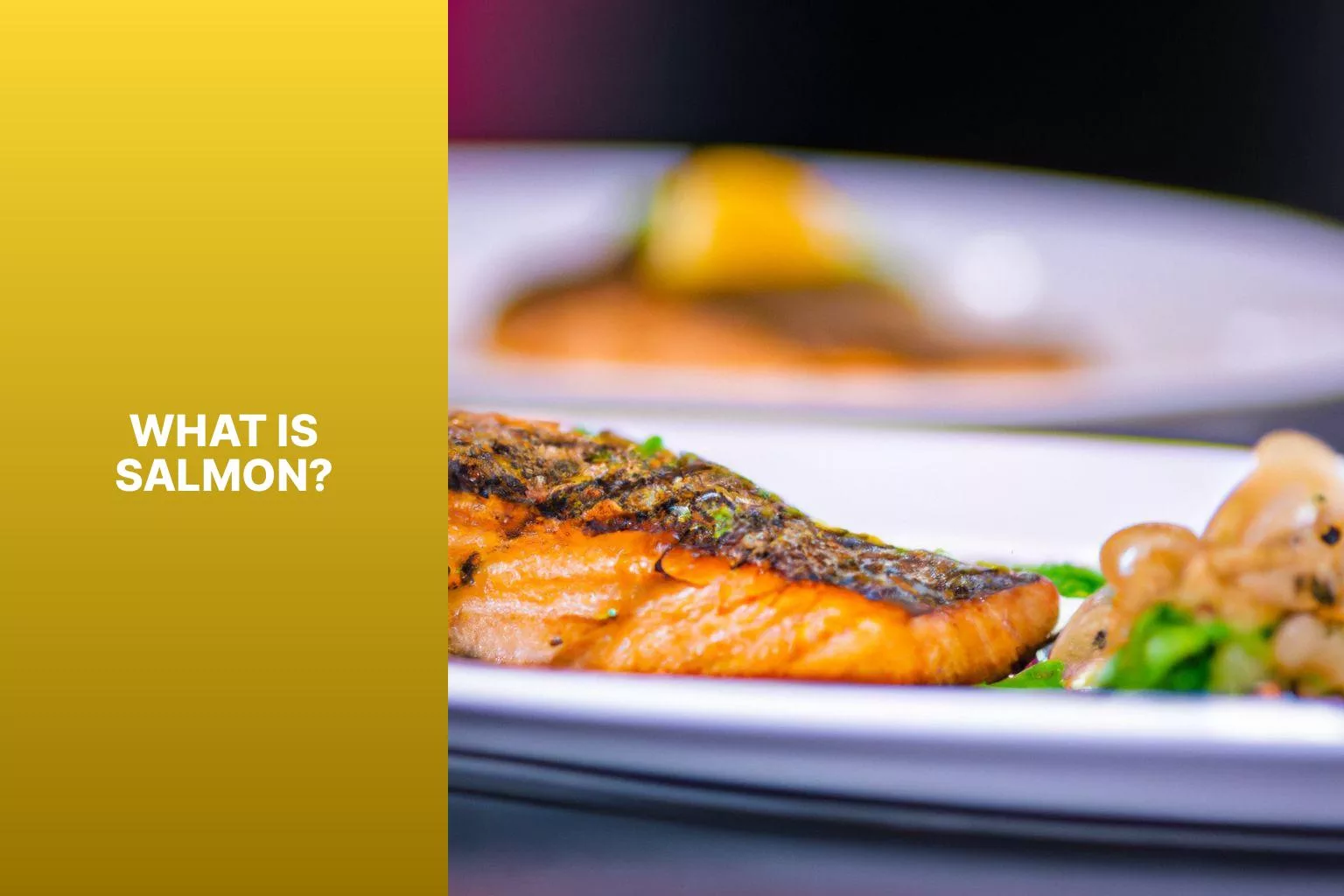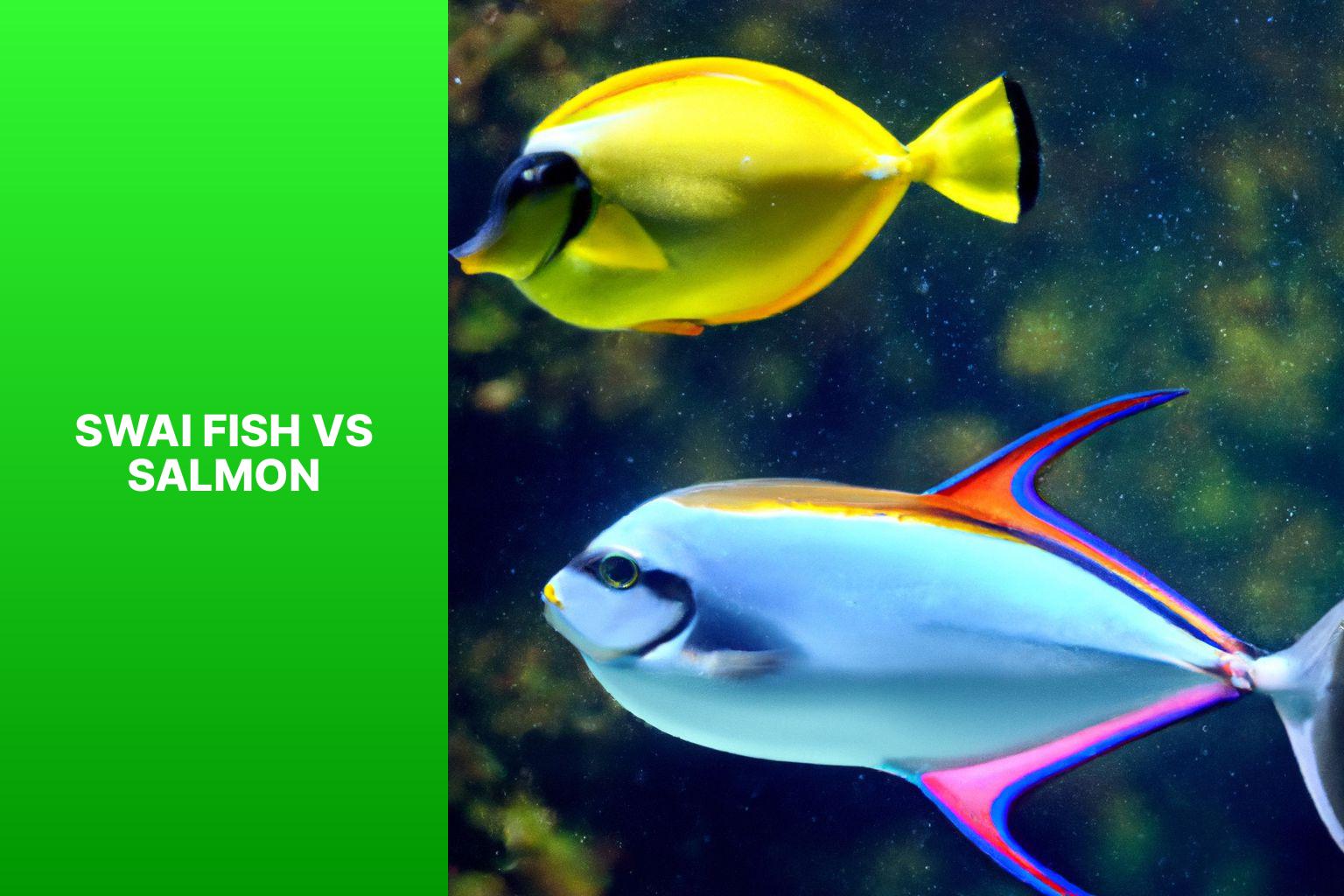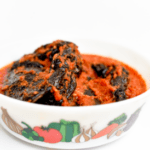“Swai fish and salmon are two popular types of fish consumed worldwide. Understanding their characteristics, nutritional profiles, and health benefits can help you make informed choices when including them in your diet. Here’s an overview of swai fish and salmon, followed by a comparison of their taste, texture, nutritional value, omega-3 fatty acid content, environmental impact, sustainability, and price. We’ll explore the health benefits and risks associated with consuming both swai fish and salmon.
Swai fish, also known as Pangasius, is a type of white fish native to Southeast Asia. It has gained popularity due to its affordability and mild flavor. On the other hand, salmon is a fatty fish species that is known for its distinctive taste and rich omega-3 fatty acid content. By comparing these two fish varieties, you can determine which one suits your taste preferences, dietary requirements, and environmental concerns.”
Key takeaway:
- Swai fish vs. salmon: Swai fish and salmon are both popular seafood choices, each with their own unique characteristics and nutritional profiles.
- Taste and texture difference: Swai fish has a mild, slightly sweet flavor and a delicate texture, while salmon offers a richer, oilier taste and a firmer texture.
- Nutritional value variation: Salmon packs a higher amount of protein, omega-3 fatty acids, and essential nutrients compared to Swai fish.
- Omega-3 fatty acid content discrepancy: Salmon is particularly rich in omega-3 fatty acids, which have numerous health benefits including heart health and brain function.
- Environmental impact and sustainability concern: Salmon farming practices often have a negative impact on the environment, while Swai fish farming is considered to be more sustainable.
- Price comparison: Swai fish tends to be more budget-friendly compared to salmon, making it a more affordable option for many consumers.
- Health benefits of consuming Swai fish: Swai fish can still provide a good source of protein and certain nutrients, making it a viable choice for those looking for a leaner seafood option.
- Health benefits of consuming salmon: Salmon’s higher nutritional content makes it an excellent choice for promoting heart health, brain function, and overall well-being.
- Risks and considerations of consuming Swai fish: Swai fish may carry a higher risk of contamination and toxins due to its farming practices and origin.
- Risks and considerations of consuming salmon: Salmon may contain pollutants such as mercury, so it’s essential to consume in moderation and choose wild-caught or responsibly farmed options.
What is Swai Fish?
Swai fish, a popular seafood choice, is much more than meets the eye. In this section, we’ll dive into the world of this intriguing fish and explore its unique characteristics. Get ready to discover the enticing overview of Swai fish and uncover its impressive nutritional profile. Prepare to be amazed by the fascinating facts and figures that make Swai fish a standout option for seafood enthusiasts.
Overview of Swai Fish
Swai fish, also known as Pangasius, is a popular seafood choice that is widely consumed around the world. Here is an overview of swai fish:
| Appearance | Swai fish has a light grey to light brown color with pinkish-white flesh. |
| Taste and Texture | Swai fish has a mild and slightly sweet flavor with a delicate, flaky texture. |
| Nutritional Profile | Swai fish is low in calories, fat, and carbohydrates while being a good source of protein. It also contains essential vitamins and minerals such as vitamin D, vitamin B12, and selenium. |
| Sustainability | Swai fish is typically farmed, and its farming practices can vary in terms of environmental impact. It is important to choose swai fish from reputable sources that follow sustainable farming methods. |
When considering swai fish as a seafood option, it is important to take into account its taste preferences, nutritional benefits, and the sustainability of its sourcing. Swai fish can be a versatile addition to your diet, providing a lean source of protein with a mild and delicate flavor. It is crucial to ensure that you choose swai fish from trusted sources that prioritize sustainable farming practices.
Swai fish offers a mild and flavorful seafood option that can be enjoyed in various culinary preparations. By understanding its overview and considering factors such as taste, nutrition, and sustainability, you can make informed choices when incorporating swai fish into your meals.
Nutritional Profile of Swai Fish
The Nutritional Profile of Swai Fish is as follows:
| Nutrient | Swai Fish |
| Calories | 105 |
| Protein | 20 grams |
| Total Fat | 2 grams |
| Saturated Fat | 0.5 grams |
| Cholesterol | 60 milligrams |
| Omega-3 Fatty Acids | 1 gram |
| Vitamin D | 10% of daily requirements |
| Vitamin B12 | 30% of daily requirements |
| Calcium | 2% of daily requirements |
| Iron | 4% of daily requirements |
| Potassium | 4% of daily requirements |
Swai fish has an impressive Nutritional Profile, with each serving providing a significant amount of protein, approximately 20 grams. It is also low in total fat, with 2 grams per serving. The saturated fat content is minimal, at just 0.5 grams. Swai fish showcases a good composition of nutrients, including omega-3 fatty acids, with 1 gram per serving, which has been proven to support heart health. It contains essential nutrients such as vitamin D, vitamin B12, calcium, iron, and potassium, albeit in smaller amounts compared to other food sources. These nutrients are crucial for various bodily functions and significantly contribute to overall health and well-being. It’s important to note that individual nutritional needs may vary, and it is advisable to consult with a healthcare professional for personalized dietary recommendations.
What is Salmon?


Photo Credits: Kabaia.Com by Walter Hernandez
Salmon, a sought-after fish, holds a special place in the culinary world. In this section, we’ll dive into the wonders of salmon, providing an overview that will tantalize your taste buds. We’ll also uncover the nutritional profile of this flavorful fish, sharing valuable insights about its rich omega-3 content and other health benefits. So, get ready to discover why salmon reigns supreme in the realm of seafood delicacies.
Overview of Salmon
| Overview of Salmon | |
| Taste and Texture | Salmon has a rich, buttery flavor and a firm, flaky texture. |
| Nutritional Value | Salmon is a nutrient-dense fish that is rich in protein, vitamins (such as vitamin D and B vitamins), and minerals (such as selenium and potassium). |
| Omega-3 Fatty Acid Content | Salmon is known for its high omega-3 fatty acid content. It is particularly rich in EPA (eicosapentaenoic acid) and DHA (docosahexaenoic acid), which are beneficial for heart health, brain function, and reducing inflammation. |
| Environmental Impact and Sustainability | Salmon is considered a sustainable seafood choice when sourced from well-managed fisheries or responsibly farmed operations. Some species of wild salmon are facing conservation concerns. |
| Price Comparison | Salmon can vary in price depending on factors such as the species, quality, and source. Wild-caught salmon is typically more expensive than farmed salmon. |
Salmon offers an overview of satisfying taste and a range of health benefits due to its nutritional profile and omega-3 fatty acid content. It is important to consider the environmental impact and choose sustainably sourced salmon to support the long-term health of fish populations and marine ecosystems. The price of salmon can vary, so finding a balance between quality and affordability is key when making a purchasing decision.
Nutritional Profile of Salmon
The Nutritional Profile of Salmon
Below is a summary of the nutritional profile of salmon:
Salmon, known for its nutritional profile, is an excellent source of protein. With 22g of protein per 100g serving, it serves as a substantial protein source. Furthermore, it contains 13g of fat per 100g, which includes 2.3g of omega-3 fatty acids. These fatty acids are essential for maintaining heart health.
In addition to its protein and fat content, salmon is significantly rich in several vital vitamins and minerals. It provides 12.5mcg of vitamin D in every 100g serving, making it an excellent source for bone health and immune function support.
Salmon also boasts high levels of vitamin B12, an essential nutrient for red blood cell production and neurological function. With 4.9mcg of vitamin B12 per 100g, it contributes significantly to the recommended intake.
Furthermore, salmon offers valuable minerals, including selenium, potassium, phosphorus, and magnesium. These minerals play crucial roles in various bodily functions, such as enzyme activity, muscle function, and maintaining electrolyte balance.
Considering the nutrient density and health benefits of salmon, it proves to be a wise and wholesome addition to a balanced diet. By incorporating salmon into your daily meals, you can avail yourself of a wide range of essential nutrients, promoting optimal health and well-being.
Comparison of Swai Fish and Salmon
When it comes to comparing Swai Fish and Salmon, there are several factors to consider that can have a significant impact on your culinary choices. In this section, we’ll dive into the juicy details of taste and texture, nutritional value, omega-3 fatty acid content, environmental impact, sustainability, and of course, the price comparison. Get ready to discover the hidden gems and surprising differences between these two popular fish options!
Taste and Texture
| Taste and Texture | Swai fish has a mild, delicate flavor that is often described as sweet and buttery. It is less fishy compared to salmon, making it appealing to those who prefer a milder taste. Swai fish also has a soft and tender texture. Its flesh is flaky and easily separates when cooked. The texture is light and smooth, making it enjoyable to eat. | Salmon has a richer, stronger flavor compared to swai fish. It has a distinct, oily taste that some people love. The flavor can vary depending on the type of salmon and how it is prepared. Salmon also has a firmer texture compared to swai fish. Its flesh is dense and meaty with large flakes. The texture can vary depending on the cut and cooking method, but it is generally more substantial. |
The taste and texture of swai fish and salmon are crucial factors in determining your preference. If you appreciate a milder, sweet flavor and a soft, delicate texture, swai fish might be the ideal choice. Conversely, if you favor a richer, stronger flavor and a firmer, meatier texture, salmon is likely to be more suitable. Ultimately, personal preference will dictate which fish you enjoy more in terms of taste and texture.
Nutritional Value Comparison
Here is a nutritional value comparison between Swai Fish and Salmon:
| Swai Fish | Salmon | |
| Protein | 20g per 100g | 22g per 100g |
| Total Fat | 5g per 100g | 13g per 100g |
| Saturated Fat | 2g per 100g | 3g per 100g |
| Omega-3 Fatty Acids | 0.6g per 100g | 2g per 100g |
| Cholesterol | 50mg per 100g | 55mg per 100g |
| Sodium | 45mg per 100g | 65mg per 100g |
| Potassium | 280mg per 100g | 450mg per 100g |
| Iron | 1mg per 100g | 0.6mg per 100g |
From the nutritional value comparison, it can be seen that both Swai Fish and Salmon are good sources of protein. Salmon, however, has slightly higher protein content with 22g per 100g compared to Swai Fish’s 20g per 100g. Salmon also contains higher total fat and saturated fat compared to Swai Fish. Salmon has a significantly higher amount of omega-3 fatty acids, which are beneficial for heart health, with 2g per 100g compared to Swai Fish’s 0.6g per 100g. Swai Fish has lower cholesterol and sodium levels compared to Salmon. Salmon contains more potassium and iron than Swai Fish.
Omega-3 Fatty Acid Content
To compare the omega-3 fatty acid content of swai fish and salmon, we can look at the table below:
| Fish | Omega-3 Fatty Acid Content (per 100g) |
| Swai Fish | 0.5g |
| Salmon | 1.9g |
As we can see, salmon has a significantly higher omega-3 fatty acid content compared to swai fish. Salmon contains approximately 1.9g of omega-3 fatty acids per 100g, while swai fish only contains approximately 0.5g of omega-3 fatty acids per 100g. Omega-3 fatty acids are essential fats that are beneficial for our overall health, particularly for heart health and brain function.
If you are looking to increase your intake of omega-3 fatty acids, salmon is a better choice compared to swai fish. The higher omega-3 fatty acid content in salmon can provide greater health benefits. It’s important to note that both fish can be part of a healthy diet and provide other valuable nutrients.
Incorporating salmon into your diet can be a great way to boost your omega-3 fatty acid intake and improve your overall well-being. Consider adding it to your meals to reap the benefits of this essential nutrient.
Remember to choose wild-caught salmon whenever possible, as it tends to have higher omega-3 fatty acid content and is more sustainable.
Environmental Impact and Sustainability
The environmental impact and sustainability of swai fish and salmon can be compared using several factors:
| Factor | Swai Fish | Salmon |
| Wild vs. Farmed | Swai fish is mostly farmed, with limited availability of wild-caught options. | Salmon can be found both as wild-caught and farmed. |
| Feed Efficiency | Swai fish has a higher feed conversion rate, consuming less feed per unit of weight gained compared to salmon. | Salmon has a lower feed conversion rate, requiring more feed to gain weight. |
| Environmental Impact | Farming swai fish has a relatively lower environmental impact compared to salmon farming, as it requires less feed, space, and water. | Salmon farming can have a higher environmental impact due to the need for more feed, larger farming areas, and potential escapement of farmed fish into the wild. |
| Overfishing and Harvesting | Swai fish is not currently overfished, and harvesting is managed to ensure sustainability. | Salmon populations have experienced overfishing in certain areas, and sustainable harvesting practices are necessary to maintain population levels. |
| Certifications | Swai fish farms may have certifications such as the Aquaculture Stewardship Council (ASC) or Best Aquaculture Practices (BAP) to ensure responsible practices. | Salmon farms may have certifications such as the Marine Stewardship Council (MSC) or Global Aquaculture Alliance (GAA) to demonstrate sustainable practices. |
Considering these factors, it can be concluded that swai fish farming generally has a lower environmental impact and higher sustainability compared to salmon farming. It is important to note that specific farming practices and certifications play a significant role in determining the overall environmental impact of both types of fish.
Price Comparison
The table below presents a price comparison between swai fish and salmon, based on current market prices:
| Product | Average Price per Pound |
| Swai Fish | $3.99 |
| Salmon | $9.99 |
As shown in the table, the price comparison reveals that swai fish is generally more affordable compared to salmon. On average, swai fish costs $3.99 per pound, while salmon costs $9.99 per pound. This price difference can be attributed to various factors, including the availability and sourcing of the fish.
It is important to note that prices may vary depending on factors such as location, seasonality, and the type of fish (wild-caught or farm-raised). Different cuts and preparations of swai fish or salmon may also affect the price.
When considering price, it is essential to balance it with other factors such as taste preferences, nutritional value, and sustainability. While swai fish may be more budget-friendly, salmon is known for its rich flavor and higher omega-3 fatty acid content.
Ultimately, the choice between swai fish and salmon depends on individual preferences, dietary needs, and budget considerations. It is recommended to compare prices at local grocery stores or fish markets to make an informed decision.
In a similar vein, when I was shopping for fish to prepare for a dinner party, I noticed a significant price difference between swai fish and salmon at the supermarket. Although I initially considered buying salmon for its reputation as a premium fish, the more wallet-friendly option of swai fish allowed me to stick to my budget without compromising on taste. My guests loved the swai fish dish, and it became a go-to choice for future gatherings.
Health Benefits and Risks of Swai Fish and Salmon
Discover the health benefits and risks associated with swai fish and salmon. From the numerous advantages that consuming swai fish can provide to the potential considerations and risks of including salmon in your diet, this section will explore both sides of the coin. Uncover the facts, figures, and events that shed light on why these two seafood options are not created equal when it comes to your health. Get ready to dive into a world of nutritional insights and make informed choices for your well-being.
Health Benefits of Consuming Swai Fish
- Swai fish offers an array of health benefits. First and foremost, it is rich in protein, providing approximately 22 grams per 3.5-ounce serving, which is crucial for muscle growth and repair.
- Additionally, Swai fish is low in calories, making it an excellent choice for individuals who want to maintain or lose weight. With only about 105 calories per 3.5-ounce serving, it is a satisfying and guilt-free option.
- One of the standout health benefits of Swai fish is its high omega-3 fatty acid content. These essential fatty acids are known for promoting brain health, reducing inflammation, and improving heart health. By consuming Swai fish, you can easily meet your omega-3 fatty acid needs.
- In addition to omega-3 fatty acids, Swai fish is also a reliable source of various vitamins and minerals. It contains important nutrients like vitamin B12, vitamin D, selenium, and phosphorus, all of which contribute to overall health and well-being.
- Another advantage of Swai fish is that it is easy to digest. With its tender and mild flavor, it is suitable for individuals with digestive sensitivities or those who prefer a milder taste.
- Lastly, Swai fish stands out for its versatility in cooking. Whether you prefer baking, grilling, frying, or adding it to soups and stews, this fish can be prepared in various ways, allowing you to enjoy its health benefits through a wide range of delicious dishes.
For more information, check out this swai fish vs salmon article.
Health Benefits of Consuming Salmon
- Salmon offers numerous health benefits when consumed regularly. It is a nutritious fish that is rich in Omega-3 fatty acids, making it beneficial for brain health, reducing inflammation, and promoting heart health. Consuming a 3-ounce serving of salmon provides about 2 grams of Omega-3 fatty acids, which contributes to overall well-being.
- The Omega-3 fatty acids present in salmon promote heart health by lowering triglyceride levels in the blood, reducing blood pressure, and decreasing the risk of heart disease. Regularly including salmon in your diet has been associated with a reduced risk of cardiovascular events.
- Salmon is not only delicious but also a good source of high-quality protein. It contains all the essential amino acids necessary for tissue repair, muscle growth, and immune function. By incorporating salmon into your meals, you can meet your protein needs and support overall health.
- In addition to being a rich source of Omega-3 fatty acids and protein, salmon provides essential nutrients such as vitamin D, vitamin B12, selenium, and potassium. These nutrients play vital roles in promoting bone health, energy production, DNA synthesis, and maintaining a healthy immune system.
- The Omega-3 fatty acids in salmon, particularly DHA (docosahexaenoic acid), are crucial for brain health and development. Regular consumption of salmon can enhance cognitive function, improve memory, and reduce the risk of age-related cognitive decline.
Incorporating salmon into your diet is an excellent way to enjoy the numerous health benefits it provides. Whether you prefer it grilled, baked, or added to salads or stir-fries, there are plenty of delicious ways to savor this nutritious fish. Ensure you choose sustainably sourced salmon to minimize the environmental impact and support the health of our oceans. Start incorporating salmon into your meals today to enhance your overall well-being and enjoy the health benefits it offers.
Risks and Considerations of Consuming Swai Fish
When considering the risks and considerations of consuming Swai fish, it is important to keep the following points in mind:
- Potential contaminants: Swai fish is often cultivated in fish farms, which may increase the risk of exposure to pollutants such as antibiotics, pesticides, and heavy metals. It is crucial to ensure that the fish comes from reputable sources that follow strict quality control measures to minimize these risks.
- Possible allergic reactions: Some individuals may be allergic to Swai fish, particularly those with seafood allergies. It is essential to be aware of any allergic reactions and to seek medical attention if any symptoms occur after consuming the fish.
- Low omega-3 fatty acid content: Compared to other types of fish like salmon, Swai fish has a lower omega-3 fatty acid content. Omega-3 fatty acids are vital for heart health and brain function. If you are specifically looking to benefit from the omega-3 fatty acids, other fish options may be more suitable.
- Lack of regulations: The production of Swai fish is not subject to the same regulations and standards as some other fish varieties. This means there may be less oversight in terms of environmental impact, sustainability, and overall production practices. It is crucial to research and choose sources that prioritize responsible and sustainable practices.
- Processing methods: The processing methods used for Swai fish can vary, and it is important to choose options that prioritize proper handling and storage to minimize the risk of contamination and foodborne illnesses.
Considering these risks and considerations can help individuals make informed choices when consuming Swai fish. It is always advisable to consult with a healthcare professional or nutritionist for personalized advice and guidance based on individual health conditions and dietary needs.
Risks and Considerations of Consuming Salmon
When it comes to consuming salmon, there are several risks and considerations to keep in mind. One of them is mercury contamination, which can be higher in larger species like king salmon due to environmental pollution. Pregnant women and young children should limit their consumption of high-mercury fish to reduce potential negative effects.
Another risk is the presence of parasites and bacteria in raw or undercooked salmon, which can lead to foodborne illnesses. It is crucial to properly cook salmon to ensure that any potential pathogens are killed and to maintain food safety.
Some individuals may develop allergies to salmon over time or be allergic to it from the start. Allergic reactions can range from mild symptoms like hives and itching to severe reactions like difficulty breathing or anaphylaxis. If you have known allergies to fish or seafood, it is important to be cautious when consuming salmon.
Considering the environmental impact, salmon fishing practices, particularly those involving wild-caught salmon, can have negative consequences. These include overfishing, habitat destruction, and the capture of non-target species. Choosing sustainably sourced salmon or alternative seafood options can help minimize the harm to the environment.
Lastly, there is a concern regarding antibiotic and pesticide residues in farmed salmon. To prevent diseases and parasites, farmed salmon may be treated with antibiotics and pesticides. Opting for responsibly farmed salmon or selecting wild-caught salmon can reduce exposure to these substances.
Some Facts About Swai Fish vs Salmon:
- ✅ Swai fish is a white fish popular in Southeast Asia, while salmon is a fatty fish popular worldwide. (Source: Our Team)
- ✅ Swai fish contains less fat and cholesterol compared to salmon. (Source: Our Team)
- ✅ Salmon is a rich source of omega-3 fatty acids, while swai fish has lower levels of omega-3 fats. (Source: Our Team)
- ✅ Swai fish is generally less expensive than salmon. (Source: Our Team)
- ✅ Salmon is considered more nutritious overall, with higher levels of vitamins and minerals compared to swai fish. (Source: Our Team)
Frequently Asked Questions
1. What is the difference in taste between swai fish and salmon?
The taste of swai fish is described as mild and neutral, whereas salmon has a rich and distinct flavor.
2. Is swai fish the same as iridescent shark catfish?
Yes, swai fish is also known as iridescent shark catfish, among other names.
3. Can swai fish be considered a freshwater fish?
Yes, swai fish is commonly found in freshwater environments, such as the Mekong basin and rivers in Southeast Asia.
4. Are there any safety concerns with consuming swai fish?
Yes, there are concerns about the use of antibiotics and chemicals in swai fish farming, as well as the potential for mislabeling. It is advisable to buy swai fish from reputable sources and cook it thoroughly to mitigate any risks.
5. How does the nutritional profile of swai fish compare to salmon?
Swai fish has a lower omega-3 fat content compared to salmon, which is known for its high levels of these healthy fats. Salmon also tends to have a higher nutritional value overall.
6. What are some healthier alternatives to swai fish?
Some healthier alternatives to swai fish include haddock, sole, salmon, and other fish with higher nutritional value and lower concerns about farming practices.




